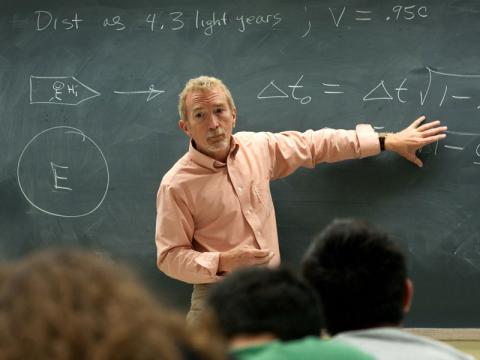
Courses Taught
PHYS 1010: Great Ideas In Science
PHYS 1210/1220: Introductory Physics I & II
PHYS 1310/1320: General Physics I & II
ENGP 2310: Introduction to Design
PHYS 2350: Modern Physics I
ENGP 3120: Materials Science and Engineering
PHYS 4470: Introductory Quantum Mechanics
Education & Affiliations
Biography
Dr. Norton's research interests include linear and non-linear wave propagation in dispersive media, ultrasound propagation through human tissue, computational physics. A new field of interest is numerical relativity.
Recent Publications
P. M. Jordan, G. V. Norton, S. A. Chin-Bing, and A. Warn-Varnas, "On the propagation of nonlinear acoustic waves in viscous and thermoviscous fluids." European Journal of Mechanics B/Fluids, 34, pp. 56-63, 2012
Robert D. Purrington and Guy V. Norton, “A numerical comparison of the Westervelt equation with viscous attenuation and a causal propagation operator,” Math. Comput. Simul., 82, (7), pp. 1287-1297, 2012. doi:10.1016/j.matcom.2010.05.017.
P. M. Jordan, G. V. Norton, S. A. Chin-Bing, and A. Warn-Varnas, "On the propagation of finite-amplitude acoustic waves in mono-relaxing media." In: S. H. Sohrab, H. J. Catrakis, and N. Kobasko (eds.), Proc. of the 5th IASME/WSEAS Int. Conf. on Continuum Mechanics (CM '10), pp. 67 - 72 (Published by WSEAS Press, 2010).
Guy V. Norton and Robert D. Purrington, “The Westervelt equation with viscous attenuation versus a causal propagation operator: A numerical comparison,” Journal of Sound and Vibration, 327, pp. 163–172, 2009.
Guy V. Norton, “Comparison of homogeneous and heterogeneous modeling of transient scattering from dispersive media directly in the time domain,” Math. Comput. Simul., 80, (4), pp. 682-692, 2009. doi:10.1016/j.matcom.2009.08.018
Guy V. Norton, “ Numerical solution of the wave equation describing acoustic scattering and propagation through complex dispersive moving media,” Nonlinear Analysis 71 (2009) e849-e854.
